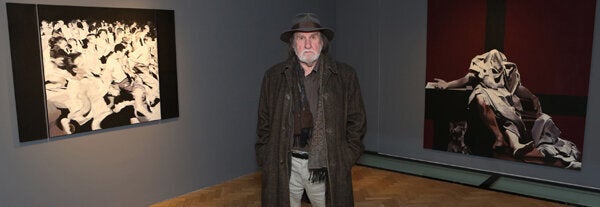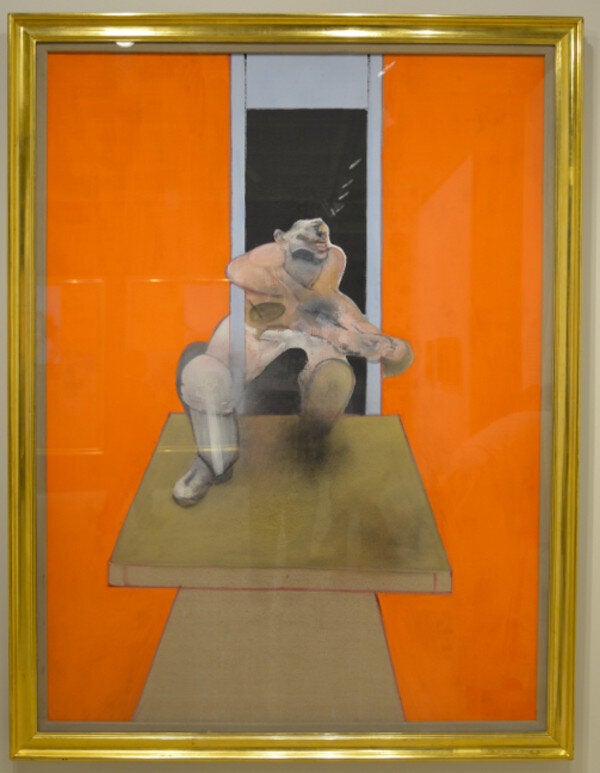The art world has been infected with the bacillus of commercialisation, a world now concerned with the shiftless tastes of Joe Normal.
One does not cavil to play devil's advocate. One is merely bored of this antiques roadshow of kultur. The post-Olympics dead time has seen a glut of art exhibitions (sponsored, of course, by benign corporations) attract to the capital the glassy-eyed autodidacts of the Shires, perennially keen to improve their lot in life by following the instructions laid down in broadsheets.

A smug tedium reigns as Lichtenstein moves in at the Tate Modern and the artefacts of Pompeii and Herculaneum receive yet another airing at the British Museum. But at least George Bellows' arrival at the Royal Academy is something to salute.
A meanness of spirit made manifest by an intellectually benumbed public, quick to delight their under-developed palates for reasons they cannot articulate, has become the enemy of art.
Yet, snugged away In Fitzrovia, an artist of little-known popular repute but considerable talent has stepped out of the shadows to show a collection of contemporary paintings which unsettle and disquiet. 'All Things Must Pass' by Neil Stokoe, showing now at The Piper Gallery (and comprising works completed in the past three years) serves as a reminder of the fickle nature of the art world.
Durham-born Neil Stokoe, a painter whose quarried face stares balefully at the world, has described his work as 'fatalistic', but he does not go far enough.
Having painted since he was a child, he says of his artistic impulse 'if you've got an itch, scratch it'. Stokoe was a comtemporary of Francis Bacon, who he refers to as 'a terrific person. His moods changed quickly, rapidly, but he was a lovely man. He didn't like having to explain his work or himself'.
And neither does Stokoe. Is it worth digging deep into an artist's psyche for an explanation of why he paints? 'Yes, I think it is,' he says, without offering further explanation. 'Bacon was the best English painter. Lucian Freud, on the other hand, was not in the same league, largely because, if looked at objectively, he was oblivious of anything that happened in the 20th century. It wasn't necessarily a weakness, but I'm sure art historians see it as one. Bacon, on the other hand, had a superior artistic intelligence.'
Stokoe is more comfortable speaking of other painters rather than of himself. But in doing so, his loquaciousness reveals the passion that dwells in his own breast which has increased his output and freed his style.
Paintings like Renunciation (2001, pictured to the right of Stokoe, above) convey the same sense of spiritual amputation and deformity evinced in Francis Bacon's work (below). The shrouded, tortured figures of Stokoe's work evoke TS Eliot's The Hollow Men; a death in life experienced by the disenfranchised, those souls slain by modern exigencies.
The paintings serve as warnings of a cultural catastrophe yet to take full shape. 'I am seeking some sort of control in life through my painting. It's a desire to make sense of the disorder of life,' he says.

He believes painting has fallen out of favour 'largely because of Marcel Duchamp. I can remember the death of painting being proclaimed every 10 or 20 years in my career. But it isn't so'.
But what is so is that consumers of art find it difficult to countenance the energy of his work, borne of his heated cerebration, not least because of the subject matter. What is visible through these works is society's inexorable retreat from enlightenment. It makes for sobering viewing. One might argue that the human sentiment of 'something not being right with the world' might inform Stokoe's work, making him one of (what David Mamet calls) the 'worried well', but it's a churlish assertion given the stark visual metaphors employed.
Stokoe, never flinching from his own subconscious, has shunned critics over his long career. 'I don't feel much about them. They were important in the past, and still are, but I don't know whether they are in a position to comment. A man like Brian Sewell talks sense, but also a fair amount of nonsense.'
Having attended the Royal College of Art at the same time as David Hockney and Allen Jones, he says he felt an affinity with Patrick Caulfield 'because he looked much more to Europe for aesthetic inspiration'. And post-war gloom, no doubt.
But the masters have passed, and are passing on, while the masses grow ever more desirous of an art form that bedazzles, rather than one which informs and demands. However, there are only so many pickled sharks at which one can nod sagely and with furrowed brow. Things may yet change for the better.
'I finish painting when all the parts add up to more than the whole,' says Stokoe, his mindscapes livid upon the walls behind him. But dread, we must, the day after tomorrow which promises to be an artless moment in time.
Cultural stasis is our national condition as time's tide washes away all art which fails to gain a toe hold in the national consciousness. And Stokoe paints on, sounding the alarm for our deafened ears as we look back into the past, lacking the courage to look forward. But if we don't yet know this, we ought to: the past will forever be another country.
© Jason Holmes 2013 / jantholmes@yahoo.co.uk / @JasonAHolmes
For more information on Neil Stokoe and 'All Things Must Pass', visit: www.thepipergallery.com
Photographs courtesy of Chloé Nelkin Consulting/Darren Gerrish & Krzysztof Osinski (c/o Creative Commons/Flickr.com)
